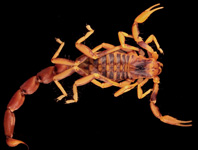Abstract
The Namanereidinae are one of the most successful polychaete groups to colonize subterranean waters. Many species have evolved adaptations to underground life including elongation of appendages and reduction of eyes and pigmentation. However, the use of these troglomorphic characters in the group’s systematics is contentious. The present study conducts a series of tree searching and phylogeny reconstructions to evaluate the influence of these characters in the phylogeny of the group. Results show that troglomorphic characters cause no serious errors in the phylogenetic reconstruction of Namanereidinae, and support the two existing genera, which can be unequivocally distinguished by non-troglomorphic traits. As a consequence of this phylogenetic hypothesis the following taxonomic changes are required: Lycastoides becomes a junior synonym of Namanereis, and its only species becomes a new combination, N. alticola n. comb. and Namalycastis occulta is moved to Namanereis becoming Namanereis occulta n. comb.
References
Alves, P.R. & Santos, C.S.G. (2016) Description of a new species of Namalycastis (Annelida: Nereididae: Namanereidinae) from the Brazilian coast with a phylogeny of the genus. Zootaxa, 4144 (4), 499–514.
https://doi.org/10.11646/zootaxa.4144.4.3
Bakken, T. & Wilson, R.S. (2005) Phylogeny of nereidids (Polychaeta, Nereididae) with paragnaths. Zoologica Scripta, 34, 507–547.
https://doi.org/10.1111/j.1463-6409.2005.00200.x
Bakken, T., Glasby, C.J., Santos, C.S.G. & Wilson, R.S. (2018) Nereididae Blainville, 1818. Handbook of Zoology online. pp. 1–44.
Conde-Vela, V.M. (2013) Namalycastis occulta n. sp. and a new record of N. borealis (Polychaeta: Nereididae: Namanereidinae) from the Northwestern Caribbean Sea. Zootaxa, 3721 (5), 475–487.
https://doi.org/10.11646/zootaxa.3721.5.3
Conde-Vela, V.M. (2017) The troglomorphic adaptations of Namanereidinae (Annelida, Nereididae) revisited, including a redescription of Namanereis cavernicola (Solís-Weiss & Espinasa, 1991), and a new Caribbean species of Namanereis Chamberlin, 1919. Subterranean Biology, 23, 19–46.
https://doi.org/10.3897/subtbiol.23.13701
Fernando, O.J. & Rajasekaran, R. (2007) A new species of Namanereidinae: Namalycastis glasbyi sp. nov. from Indian waters. Bombay Natural History Society, 104, (1), 64–67.
Fiege, D. & Damme, K. Van (2002) A new species of polychaete (Polychaeta: Nereididae: Namanereidinae) from the Socotra Archipelago, Yemen. Fauna of Arabia, 19, 239–244.
Fitzhugh, K. (1987) Phylogenetic relationships within the Nereididae (Polychaeta): implications at the subfamily level. Proceedings of the Biological Society of Washington, 7, 174–183.
Glasby, C.J. (1991) Phylogenetic relationships in the Nereididae (Annelida: Polychaeta), chiefly in the subfamily Gymnonereidinae, and the monophyly of the Namanereidinae. Bulletin of Marine Science, 48, 559–573.
Glasby, C.J. (1997) A new species of Namanereis (Polychaeta: Nereididae: Namanereidinae) in groundwater of the Sultanate of Oman, Arabian Peninsula. Beaufortia, 47, 157–162.
Glasby, C.J. (1999) The Namanereidinae (Polychaeta: Nereididae). Part 1, taxonomy and phylogeny. Records of the Australian Museum, 25, 129.
Glasby, C.J. & Timm, T. (2008) Global diversity of polychaetes (Polychaeta; Annelida) in freshwater. Hydrobiologia, 595, 107–115.
https://doi.org/10.1007/978-1-4020-8259-7_13
Glasby, C.J., Fiege, D. & Van Damme, K. (2014) Stygobiont polychaetes: notes on the morphology and the origins of groundwater Namanereis (Annelida: Nereididae: Namanereidinae), with a description of two new species. Zoological Journal of the Linnean Society, 171, 22–37.
https://doi.org/10.1111/zoj.12130
Glasby, C.J., Miura, T., Nishi, E. & Junardi, M. (2007) A new species of Namalycastis (Polychaeta: Nereididae: Namanereidinae) from the shores of South-east Asia. The Beagle, Records of the Museums and Art Galleries of the Northern Territory, 23, 21–27.
Goloboff, P.A. (1997) Self-weighted optimization: tree searches and character state reconstructions under implied transformation costs. Cladistics, 13, 225–245.
https://doi.org/10.1111/j.1096-0031.1997.tb00317.x
Goloboff, P.A., Farris, S. & Nixon, K. (2008) TNT, a free program for phylogenetic analysis. Cladistics, 24, 774–786.
https://doi.org/10.1111/j.1096-0031.2008.00217.x
Magesh, M., Glasby, C.J. & Kvist, S. (2014) Redescription of Namalycastis glasbyi Fernando & Rajasekaran, 2007 (Annelida, Nereididae, Namanereidinae) from India. Proceedings of the Biological Society of Washington, 127, 455–465.
https://doi.org/10.2988/0006-324X-127.3.455
Magesh, M., Kvist, S. & Glasby, C.J. (2012) Description and phylogeny of Namalycastis jaya sp. n. (Polychaeta, Nereididae, Namanereidinae) from the southwest coast of India. ZooKeys, 43, 31–43.
https://doi.org/10.3897/zookeys.238.4014
Marques, A.C. & Gnaspini, P. (2001) The problem of characters susceptible to parallel evolution in phylogenetic reconstructions: suggestion of a practical method and its application to cave animals. Cladistics, 17, 371–381.
https://doi.org/10.1111/j.1096-0031.2001.tb00131.x
Martini, M. & Ortega-Gutiérrez, F. (2018) Tectono-stratigraphic evolution of eastern Mexico during the break-up of Pangea: A review. Earth-Science Reviews, 183, 38–55.
https://doi.org/10.1016/j.earscirev.2016.06.013
Nixon, K. (2002) WinClada. Version 1.00.08. Published by the author, Ithaca, NY. [software]
Pinna, M.C.C. de (1991) Concepts and tests of homoloogy in the cladistics paradigm. Cladistics, 7, 367–394.
https://doi.org/10.1111/j.1096-0031.1991.tb00045.x
Pleijel, F. (2001) Nereididae Johnston, 1865. In: Rouse, G. & Pleijel, F. (Eds.), Polychaetes. Oxford University Press, Oxford, pp. 96–99.
Read, G. & Fauchald, K. (Eds.) (2018) World Polychaeta database. Nereididae Blainville, 1818. Accessed through World Register of Marine Species, available from: http://www.marinespecies.org/aphia.php?p=taxdetails&id=22496 (accessed 1 August 2018)
Ross, M.I. & Scotese, C.R. (1988) A hierarchical tectonic model of the Gulf of Mexico and Caribbean region. Tectonophysics, 155, 139–168.
https://doi.org/10.1016/0040-1951(88)90263-6
Santos, C.S.G., Pleijel, F., Lana, P. & Rouse, G.W. (2005) Phylogenetic relationships within Nereididae (Annelida: Phyllodocida). Invertebrate Systematics, 19, 557–576.
https://doi.org/10.1071/IS05001
Wesenberg-Lund, E. (1958) Lesser Antillean Polychaetes, chiefly from brackish water. Studies on the Fauna of Curaçao and other Caribbean Islands, 30, 1–41.
Wilson, R.S. (2000) Family Nereididae. In: Beesley, P.L., Ross, G.J.B. & Glasby, C.J. (Eds.), Polychaetes & Allies: The Southern Synthesis. Fauna of Australia. Polychaeta, Myzostomida, Pogonophora, Echiura, Sipuncula. CSIRO, Melbourne, pp. 138–141.

